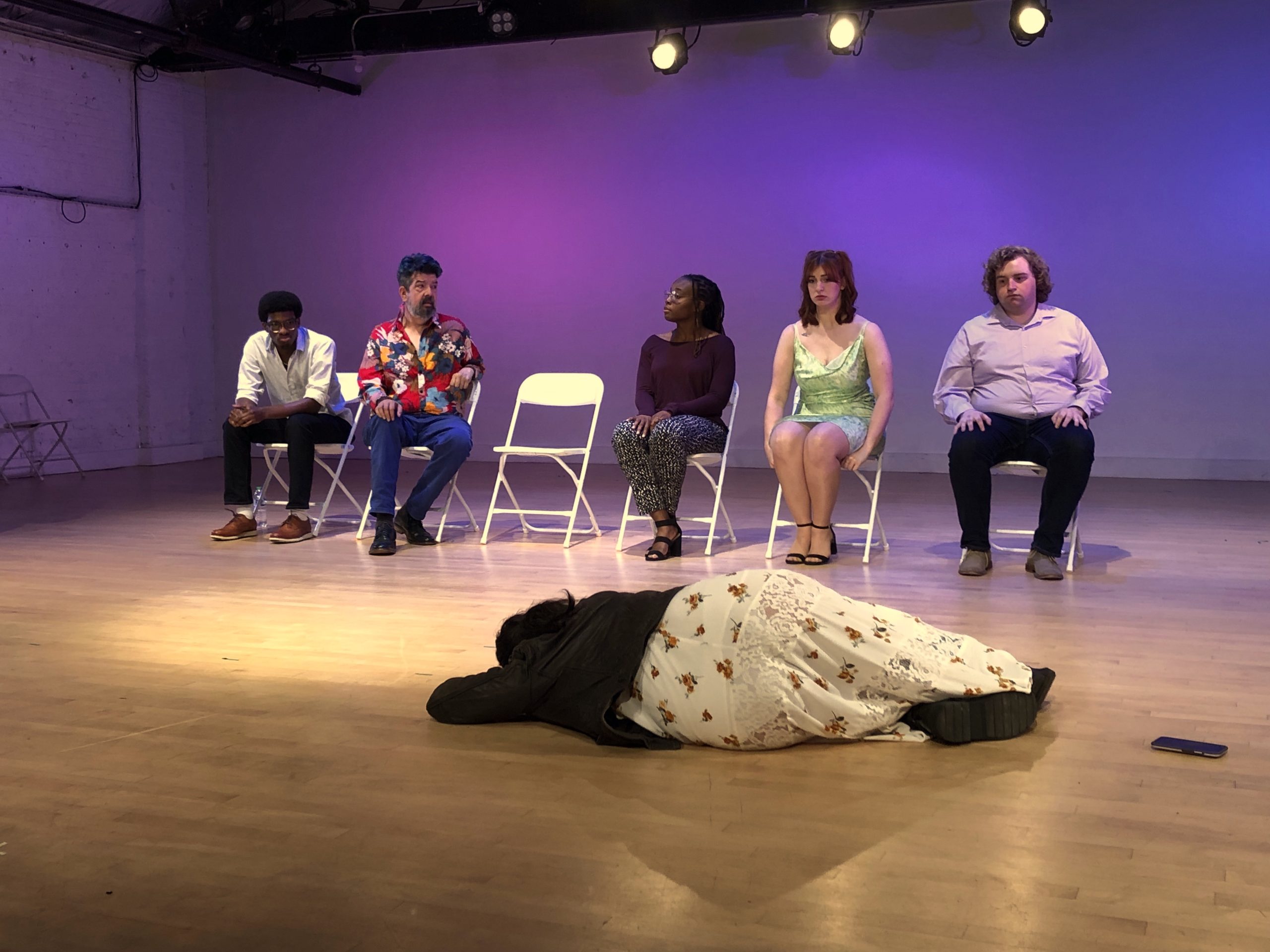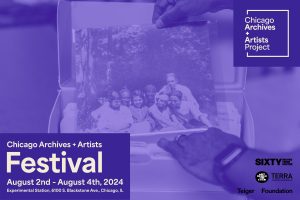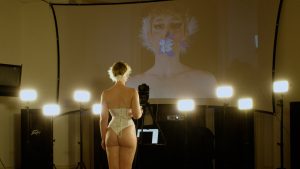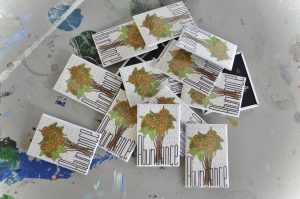A minimalist bordering on ascetic, Shea Leavis insists that the fastest way to Links Hall is on foot. “You have to walk to the bus anyway, and then wait for it!” The theater is a forty-minute trek from their apartment in Ravenswood, and the ninety-degree air is viscous. But it’s Wednesday of tech week. Who am I to argue with the director?
Thoroughly sticky by the time we reach the 7/11 on Belmont and Western, we acquire rations—yellow Gatorade Zero for Shea, lemon Yerba Mate for me, some trail mix, some chunks of pineapple. We know a long night awaits. We both eye the buffalo chicken wings, but do not open the case.
Links Hall is gorgeously cool, dark, and empty when we enter, just after four o’clock. Lighting designer Max Halperin is perched at the tech table, reprogramming the opening look. He’s already been there an hour.
In praise of Max and of sound designer, Miranda Coble, Shea remarks to me that both can be relied upon to do their duty for art. This phrase, lifted from the manifesto of German interdisciplinary artist Jonathan Meese, has become something of a mantra among our theater-making friends recently. Do your duty for art, we remind ourselves, as we spend upwards of twenty hours a week creating experimental theater, sans institutional backing, for low or no pay, on top of our full-time jobs. You have to just do your duty, and love art.
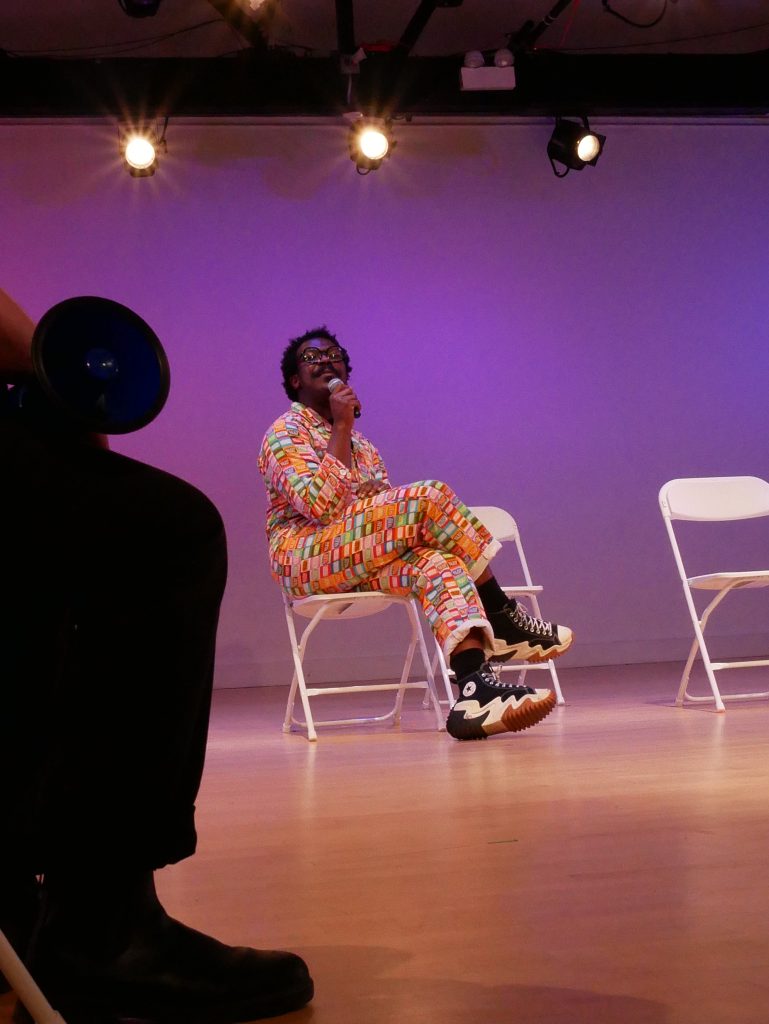
Playwright Elliot Schiff and I met in early 2022 in a workshop where this play was born, both relatively new to a Chicago whose theater scene was just barely beginning to limp out of pandemic dormancy. We found a friendship and artistic camaraderie which sustained us through the subsequent months of readings, workshops, grad school applications, experiments in performing, and finally this summer, both of our first full productions as playwrights.
When I met Shea, they were still living in Brooklyn and fresh off directing the first staged reading of their play Friends by Elliot Schiff. I deduced that the collaboration had gone well; in the weeks leading up to the reading, Elliot had been furiously drafting new pages and emailing them in batches to Shea, who read them all and responded over multiple hours-long Zoom calls. By summer’s end, Shea had come to a spontaneous decision to leave behind a seven-year career in New York’s downtown theater scene and move to Chicago. A whirlwind collaborative romance if ever I saw one.
Yet with respect to their individual artistic proclivities, the two form something of an odd couple. Elliot is a playwright with a strong literary orientation, who crafts linguistically dense, topical plays with rich characters and a comedian’s ear for pace and punchline (they are also a practicing improviser and standup comic.) A child of Los Angeles, their work often roams the physical and emotional landscape from which our nation’s popular culture springs. Their first play, Here Kitty, is a brutally funny semi-autobiographical undressing of a fraught mother-son relationship in suburban Santa Monica, where the time is “Right now. Before now. After now. Always a Los Angeles Winter” and the appearance of the father, a big-shot Hollywood producer, is conspicuously rare. I’m Not Here to Make Friends takes aim at the entertainment industry more directly, set on the soundstage of a fictional reality TV show, Are You the One? Or Is Your Dad? in which bisexual contestants compete to sleep with all four members of an adult nuclear family. The play is a large, boisterous thicket of banal contemporary speech; under hot lights, the characters do battle with “stuff” and “hot guy” and “I don’t know” and “uh” and “like” and “nice body” and “skinnyfat” and the “I I I I” in an effort to articulate a coherent conception of their desires, their genders, their selves, and each other.
Shea, for their part, admits it’s not the sort of thing that they would ordinarily direct: with the exception of one season of Survivor five years ago, they’ve never watched reality television. An abstract formalist, they typically gravitate less towards character-driven dramatic fictions, and more towards the kind of task-oriented, non-naturalistic performance styles practiced by companies like Royal Osiris Karaoke Ensemble, Nature Theater of Oklahoma, and in Chicago, the Neo-Futurists. These companies, though distinct in their aesthetics, are bound by a shared rejection of pretending onstage. They aim instead, as Shea puts it, “to create actual problems in the actual space that the actual people in the actual room have to figure out.” In the spirit of a true experimentalist, however, Shea is loyal to no dogma. Plus, they insist that the resistance created by working outside of one’s preferred genre can be productive. And so they took on the play.
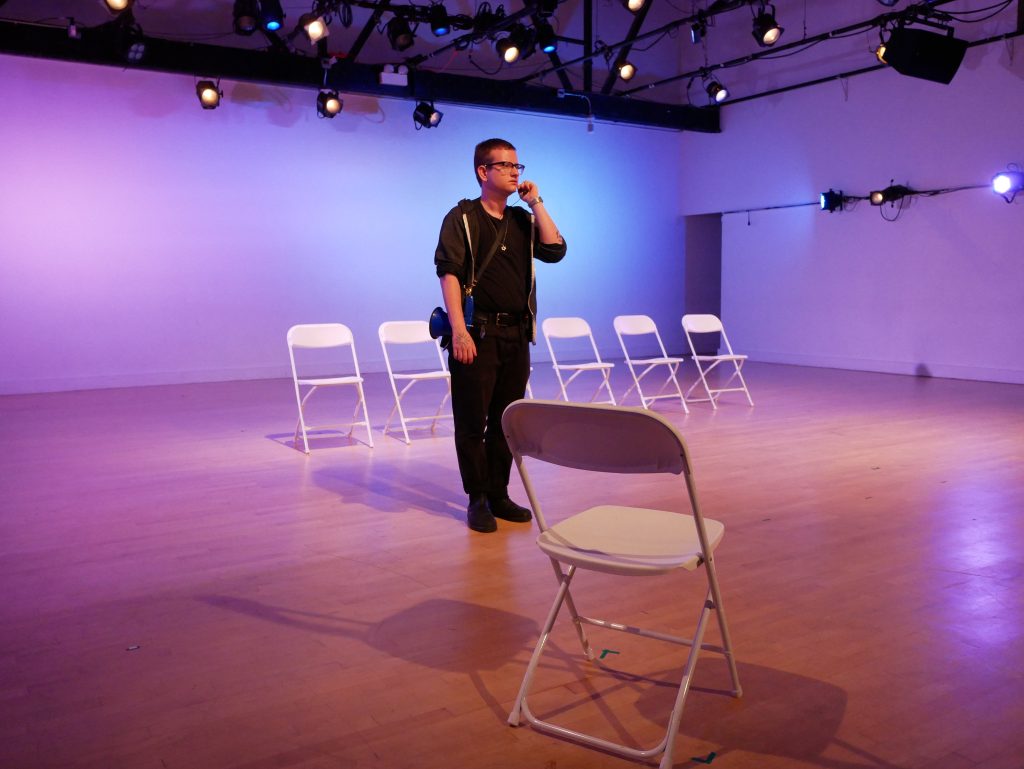
While we wait for Elliot, who is currently cycling about the city to retrieve odds and ends for the cast and team, Max futzes with cues, and Shea stands in for actors, idly reciting the lines spoken in each particular zone of light. There is something underappreciated about directors, which is true of all the good ones I know: they tend to have the entire play memorized. This is no small feat for this text, which is rife with strange repetition, clipped half-sentences, and circular arguments. Take what is perhaps my favorite exchange in the play, between ex-spouses Mike and Cynthia:
CYNTHIA: BINKY BINKY BINKY
You better
BINKY BINKY
BINKY!
BINKY!
Mike I swear to god if you don’t
BINKY BINKY BINKY BINKY BINKY BINKY
Mike I need you to BINKY
BINKY
BINKY
MIKE: Bonky.
CYNTHIA (Moved): Thank you. (Pause)
ALEX: What.
MIKE: Our Pomeranians.
ALEX: What.
CYNTHIA: We say their names. To each other. When we want to know that everything between us is alright. One of us says Binky,/ which means “am I okay?” And the other says “Bonky,”/ which means, “yes, you’re okay.”
(Beat.)
They’re both dead.
MIKE: Bonky. Binky. Oh.
MIKE: Binky,/ he was
CYNTHIA: Bonky
MIKE: No
CYNTHIA: Oh
MIKE: Bonky
CYNTHIA: Binky.
MIKE: Bonky.
CYNTHIA: Binky Binky
MIKE: Bonky bonky. Binky died first. Lily was eight, Ben ten. Where was I? I was. I was talking about what I’ve gained from this show. From my time here. Why did you…?
CYNTHIA: Why did I what.
MIKE: Why did you need it.
CYNTHIA: Binky
MIKE: Bonky. Right. My reassurance. Why did you need it.
It was, in large part, an interest in this peculiar linguistic quality that drew Elliot to this subject matter in the first place. “I can promise you that from a language crackling standpoint,” they tell me, “almost any confessional in a reality show will do laps around ‘The Sopranos’ any day.” The depth of their research and enthusiasm is palpable in the play, which is smartly organized in terms of the important structural elements of the genre: Act I follows the process of shooting confessionals (cutaway sequences in which cast members comment on already-recorded scenes), while Act II reconvenes the cast and crew for a live “reunion episode” after the show has aired. Conflicts erupt at the behest of “Bossman”, the physically absent director who provokes the cast through the mouthpiece of his child, Alex (Seph Mozes), a “nepotism hire” whose performatively good intentions never quite hold up against the filial mandate for melodrama.
Not that the Jefferson family needs much prompting to start going at it. Matriarch Cynthia (OOshene Fox) searches in vain for shreds of emotional intimacy and validation, while her newly-out ex-husband, Mike, (a wild-eyed Donaldson Cardenas) is consumed by his affair with contestant Charlie (an unsentimental Michael Oakes). Their daughter Lily (Haley Bolithon), rails against her mother’s self-absorption in response to the revelation of her bisexuality on air. (“Ding dong! Telegram for Cynthia…it says, ‘Let me refresh your narcissism-addled cobweb of a brain: you think I’m queer because I hate you?’”) All the while, smooth inscrutable Malik Middleton as Ben ruthlessly trivializes his family members’ problems (in response to his sister’s suicidality: “Lily was all ‘ohhhh woe is me who am I who am I I’m a child of divorce! What a unique position for unique little me to go through.’”)
If all four family members seem, to varying degrees, genuinely preoccupied with the romantic-relational component of the show, bisexual contestants Babette (hilariously dewy in Megan Kueter’s portrayal) and Charlie are clearly in it for the sole purpose of advancing their acting careers. Charlie has a tic whereby he yells “Juilliard” every time he “acts good”, while Babette sits upstage, listening for compelling tidbits of dialogue with which to “expand her range”. (“They’re DEAD? That was pretty good. Grief! I can do grief now, cool.”)
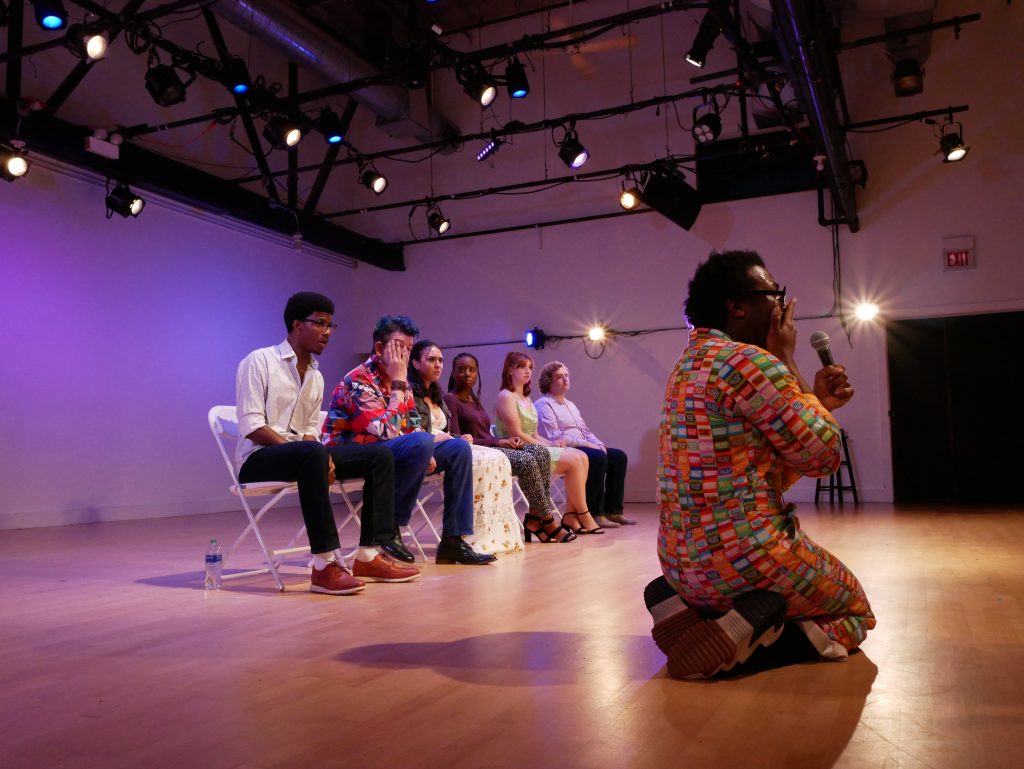
Tonally, the play walks a line between satire and existentialism; it is clear that its characters play no small part in creating the absurd predicaments they can’t seem to extract themselves from. Still, fundamentally systemic thinker that they are, Elliot’s sharpest critique is reserved for the reality TV machine itself. While broadly evident in the ire that develops between cast and production team, the barbarity of the system can be felt all the way down to the truncated, manic quality of the characters’ speech. Elliot remarks that “we’re getting to a point in reality TV, especially with influencers and stuff, where everybody knows exactly what they’re getting into. And still people are interrupting themselves, unable to speak clearly, reaching their breaking points. And a lot of that has to do with the conditions on sets: you’re trapped in these places. You have very little agency. You are being spoon fed alcohol 24/7. The psychic conditions that form on these sets are horrible.”
Perhaps the most tragic consequence of these conditions, however, is felt not by any cast member but by the lonely B-camera operator, Robbie, in a sensitive portrayal by Arshad Baruti. Although he spends the bulk of Act I “offscreen,” silently framing shots, we learn in a moving soliloquy that he is mourning the loss of Nicole, a former coworker who, exhausted by the punishing hours of a previous shoot in Santa Barbara, fell asleep at the wheel and died. Robbie remarks that, “The execs, they didn’t have to drive back to LA. They slept in these huge houses right by set—I bet the houses, each one probably had like five empty bedrooms each—you know what? Come to think of it, yeah, I bet the studios paid for the execs’ housing. Us, they gave us nothing.” By the time we return for the reunion episode in Act II, Robbie is dead by the same cause.
At five o’clock the playwright arrives, windswept and gangly. They drop their neon high-visibility bike bag on a chair and unload their acquisitions: “This is a sweater for my stage manager, these are beans for my cast that I cooked, this is a play that one of my cast members wanted to read that I am lending them, here are all the batteries we need for the show.” They turn to me, teasing: “Are you getting all this?”
Leaving the designers to their duties, Elliot, Shea, and I sprawl on the floor of the empty Constellation space next door to begin our conversation. I want to get them both on the record about one particular subject: the choice to cleave the two acts into starkly different styles. The first act is spoken entirely in a monotonous flat affect, with each performer’s movements strictly limited to a set vocabulary of stylized gestures, while the second is performed as a naturalistic play.
When Shea first told me of their interest in this direction, I was jazzed. I was midway through the run of my own show, which featured a number of experimental staging concepts that had proven controversial amongst both collaborators and audience members. Weary of defending these choices against detractors, I was energized to learn of a peer plotting to try something unusual and hard. Shea would sometimes sit with me for hours after my performances, nursing gin and tonics at the Jarvis Square Tavern while I egged them on. “Yes,” I declared, “the juxtaposition of experimental performance and naturalistic acting onstage! This is the project of our generation!”
At the same time, I had reservations about the concept—whether it would work against the script instead of for it, and whether it would work in Chicago, where verisimilitude typically reigns supreme. At that time, the idea was even more unwieldy than what it eventually became; Shea was dreaming of dividing the Act I playing space into four quadrants, each of which would be assigned an arbitrary rule, affect, or gesture—e.g. in the upstage left quadrant, regardless of what your character is saying or doing in the scene, you must always be smiling, but in the downstage right quadrant, you must only gesticulate with your hands using peace signs, and so on. What’s more, they intended to reset the rules between every rehearsal and every performance, lest anything should become too rehearsed and therefore stale.
This sort of rule system is not in itself an untested technique, but I had never heard of someone attempting to apply it to a new play, already so thick with character, dialogue and plot. I wondered how or whether the performer’s real-time struggle would map on to the character’s fictional one. I wondered still more how they were going to get everyone on board. “What are you going to tell the actors,” I pressed, “when they ask you what any of this has to do with the story they’re telling?”
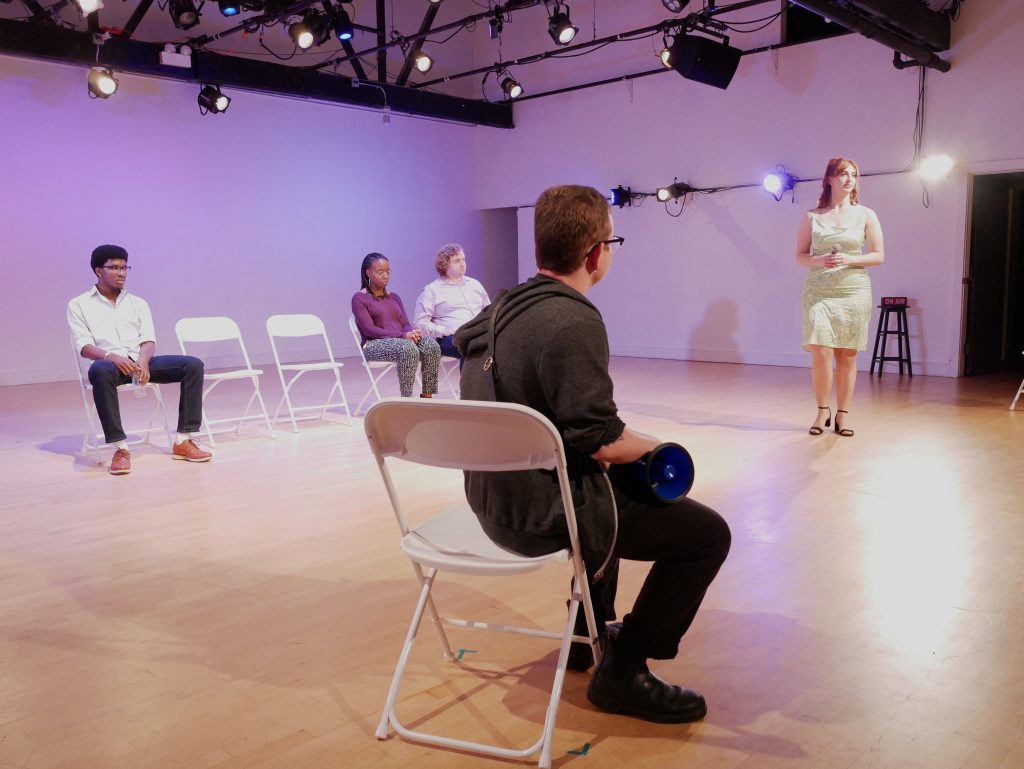
Unruffled, Shea drew me the link that they intended to offer the cast: “I perceive the play to deal with people who are having a hard time piecing their identity together, they told me. They have their personal history sculpting their habits in ways they resent. They have the immediate pressure to perform for an audience. They have their relationships with their family adding external pressure to be a certain way. To me, creating a series of external restrictions is an attempt to mirror the puzzle the characters have…of figuring out how to take the desires of others, the limits placed on them by others, and incorporate them to their own way of being, in real time.”
They had already primed Elliot to anticipate that this approach might cause a confluence of unexpected feelings to show up at surprising moments: even a sad monologue about the loss of one’s dog delivered while smiling and hopping on one leg is liable to become a laugh line. Shea also maintained that they were prepared to abandon the concept at any point if it wasn’t working. When I asked Elliot how they were feeling about this gameplan, they seemed unfazed. “It’s exhilarating to watch people try to figure something out in real time,” they told me. “Much more so to me than people trying to shoot a free throw exactly the way that they know how to and have practiced 10 million times. I would be acting against my own opinions and values that I’d been developing over the last few years if I was like, ‘no, I think we should do Meisner, or whatever.’”
Both collaborators concur that the experimental gestures work best when their use is restricted to the first act. “If you did the whole play the way that Act I lives,” Shea theorizes, “it might just feel really contrived. And if you looked at the whole thing just in the more naturalistic way that Act II is, you might not question any of the rules that we take for granted about how people are supposed to be on stage. But that if you’re able to observe that flip, then maybe it gives you an insight that to me is in the play, which is that dividing the ways that people express themselves into being performative and being authentic—what’s me and what’s out there—is a dichotomy that doesn’t work.”
Elliot adds, “I also think it’s fun. I think it’s fun for the actors in Act II, to have all this tension and then let it rip.”
From what I could glean, things were chugging along for the first few weeks, as the cast gamely attempted to roll with an evolving concept. Week one was spent sketching the general outline of the staging, sans any conceptual or gestural work. It was quickly discovered, in week two, that the quadrant system would not have the desired effect; according to Shea, “there’s not a lot of internal movements within each scene of the play. It is very much like we are filming this moment, so everyone is organized in space this way. Then we move on to the next moment. I didn’t want it to turn into the rules just moving as the scenes moved.”
To combat this, they abandoned the original list of arbitrary rules in favor of working with the actors to develop what Elliot calls a “body grammar” for each character, which Shea defines as “a series of abstract gestures that they generated themselves using particular moments in the text, which they are free to use as they like.” (This approach calls to mind the non-realist “psychophysical actions” developed by Stanislavski and later Grotowski.) These gestures having been found, however, I wondered how the actors determined when to implement them, absent the chance operation that the quadrants had provided. Here, too, the strategy became about embracing the relational dynamics embedded in the text: “if the actors know what narrative threads they’re invested in,” Shea explains, “and have moments where they know that they are having a kind of emphatic response to things, then what they have the tools to do is say, ‘I need to erupt with something in this moment. But the rules tell me that the way that might show up cannot be what I would do if there were no rules. So I’m going to replace that with some gesture. And it is my responsibility to internally figure out what that means.’ The viewer doesn’t need to know that twirling [the actor’s] fingers around in this way means, ‘I’m bummed,’ as long as the actors are confident in the fact that there is this Rube Goldberg-like movement of causality happening.”
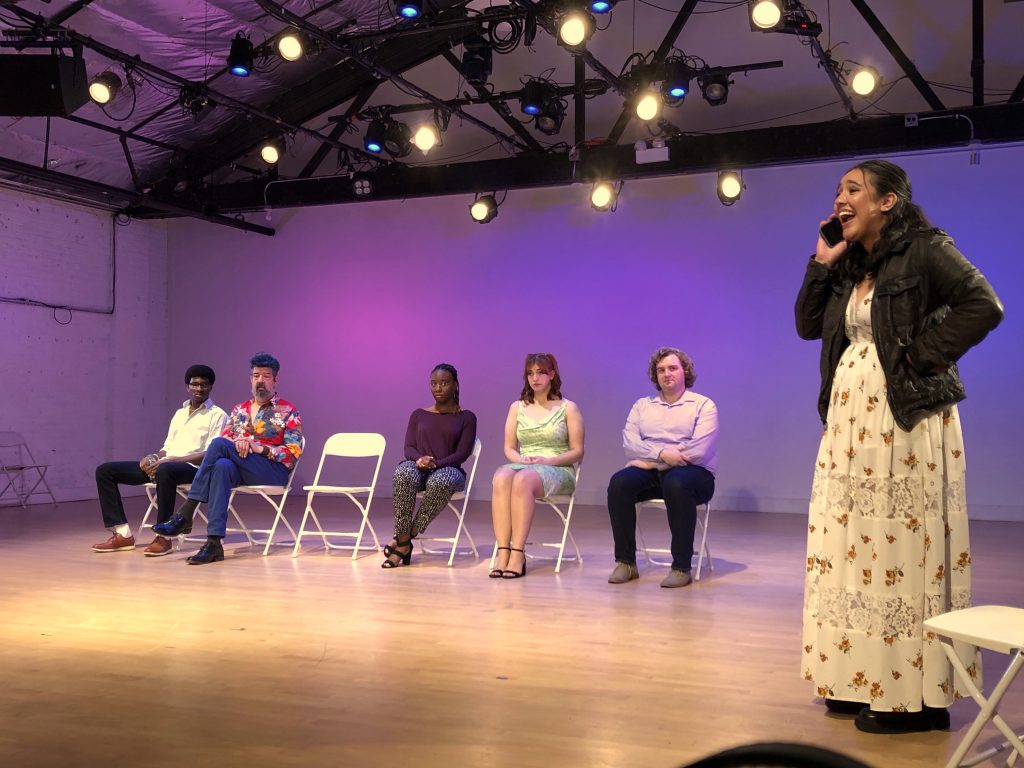
The other key element of the Act I staging is the distinct vocal affect, which Shea compares to the muted performance style in the films of Yorgos Lanthimos (“The Lobster,” “Killing of a Sacred Deer”). Characterized by a constancy of pace and a distinct lack of put-on emotion, it sounds as though a person with absolutely no preconceptions about “acting” is plainly reading a text aloud. Shea’s decision to implement this idea roughly coincided with Elliot’s submission of the final script in late June. A fastidious editor of their own work, Elliot had spent the week leading up to the script-lock date shut away during rehearsal, combing over and refining every last word, beat, and silence. Meanwhile, Shea was in the next room developing a system that threatened to upend most if not all of these textual specificities. On the Saturday the draft was due, the three of us gathered in my living room and did a read-through so that Elliot could hear the recent changes aloud. At one point, we paused for the playwright to take a call, and Shea and I retreated to my back stairwell. While they smoked a cigarette, I chomped on granola, reeling slightly from the athletic demands of performing this script: I had forgotten just how dense it was, how relentless, how fast. It also felt like Elliot and Shea might be working on two parallel but separate projects: Elliot a literary text, and Shea a choreographic experiment, each with their own specific rigor but vastly different goals.
A few days later, though, Shea texted me a post-rehearsal update: “all things gesture…preserved…but instead of starting to layer in crazy vocal decisions ‘this part is all laughy, this part is all cryey, this part is all panicked etc’, Act 1 will be spoken monotone. I think this will allow 1) me to preserve my goal to try and explode what we take for granted about the way we link emotion and behavior while 2) sustaining an attentiveness to the rhythm of the play that I believe will 3) converge my pursuit with Elliot’s.”
Around six o’clock, the actors begin to arrive. (Me: “Do you need to go?” Elliot: “I want to poke my head out there and let them know their beans are here.”) We wrap up our conversation, and I take my seat to watch the run. Shea gets the actors in a big circle for warm-up, while Producer/Stage Manager/Jack-of-All-Trades Anna Aguiar Kosicki holds potential costume pieces under the light, deliberating. In my notebook, I set up a list under each character’s name. My goal is to catalog the gestures as comprehensively as possible—to dissemble the Rube Goldberg machine and behold its component parts.
Fortunately, there is nothing to distract my eye from this endeavor in Shea’s characteristically austere staging, which employs zero scenic elements apart from eight standard-issue white folding chairs, and one light-up “On Air” sign which doesn’t appear until Act II. Max’s lighting design does most of the atmospheric work, bathing the stage in a warm, white dancerly sidelight. Occasionally, we are plunged into a dark pink backlit void for the “walkie-talkie” sequences, in which a string of disembodied voices, representing the onlooking film crew underlings, comment on the proceedings and on their own personal dramas. (Elliot voices a character in these sequences prone to bizarre ruminations: “I went into debt on the frozen cum and on a bunch of designer dresses, but honestly, I feel so good, I feel like, you know, gender is constructed socially, and like, I’m doing it.”)
The performers spend the majority of the act standing in line and speaking directly to the audience, periodically turning to face one another with crisp pivots. The effect of the monotone onstage is both defamiliarizing and comic: instead of flattening the crude absurdity of Elliot’s text, it accentuates it—imagine Siri saying “bag that cutie yes girl.” By eschewing the tonal variation that typically clues us into where a speaker is headed rhetorically, Shea has managed to make every word land as a surprise.
In my gesture-cataloging quest, I accumulate the longest list by watching Cynthia, who has at least eleven distinct moves, including: 1) a hand motion that looks like grinding pepper; 2) a little dance that would be at home on TikTok; 3) a coquettish tucking of the hair behind the ear; 4) a circling of both pointer fingers in the air ending with an authoritative pointing of both towards the audience; 5) a nervous scratching of both forearms; 6) a raising of both hands in front of the face, as if holding a book aloft; 7) a curvature of both palms in air, as if tracing the outline of a Venn diagram; 8) a confident marching-in-place; 9) a pensive combing of the fingertips across the forehead; 10) a jazzy wiggling of the fingertips; and 11) a covering of both ears with clawed hands. OOshene seems totally fluent in her vocabulary, continually recombining the gestures to create new phrases, allowing each movement to infect the tone of the next one. I don’t know why Cynthia grinds pepper in one moment and covers her ears in the next, but I can feel a coherent grammar at work.
At times, the relation between gesture and text feels directly symbolic, as when Robbie tells the story of Nicole’s death by car accident. Arshad illuminates the words with a seamless and devastating sequence: a slow raising of both fists becomes his rage, which becomes her hands on the steering wheel, which becomes two empty palms upturned in supplication, which becomes two hands clasped in defeated complacency. It’s a tragic moment, afforded just enough space to avoid sentimentality—“just got word from bossman,” Alex interjects, “he says to shut up and pick up your camera.” And the machine goes on whirring.
By the close of Act I, I feel almost hypnotized, having lived so long inside of this same relentless tone. To sustain such sameness is against the classical mandate that good directing be about identifying the inflection points in the text and underscoring them. Sure, boredom may arise, but the play continues apace, inviting me without coercion to move through that feeling and into something else.
What I move into is hunger. The 7/11 chicken wings call to me, and I slip out of the theater into the humid dusk. While Elliot distributes beans, Shea smokes with a few actors outside. They offer me a credit card to buy them some chicken wings. I refuse it. I’ll buy them myself; I’ll help feed the minds that made this play. In the face of a great achievement, I might do my small duty for art.
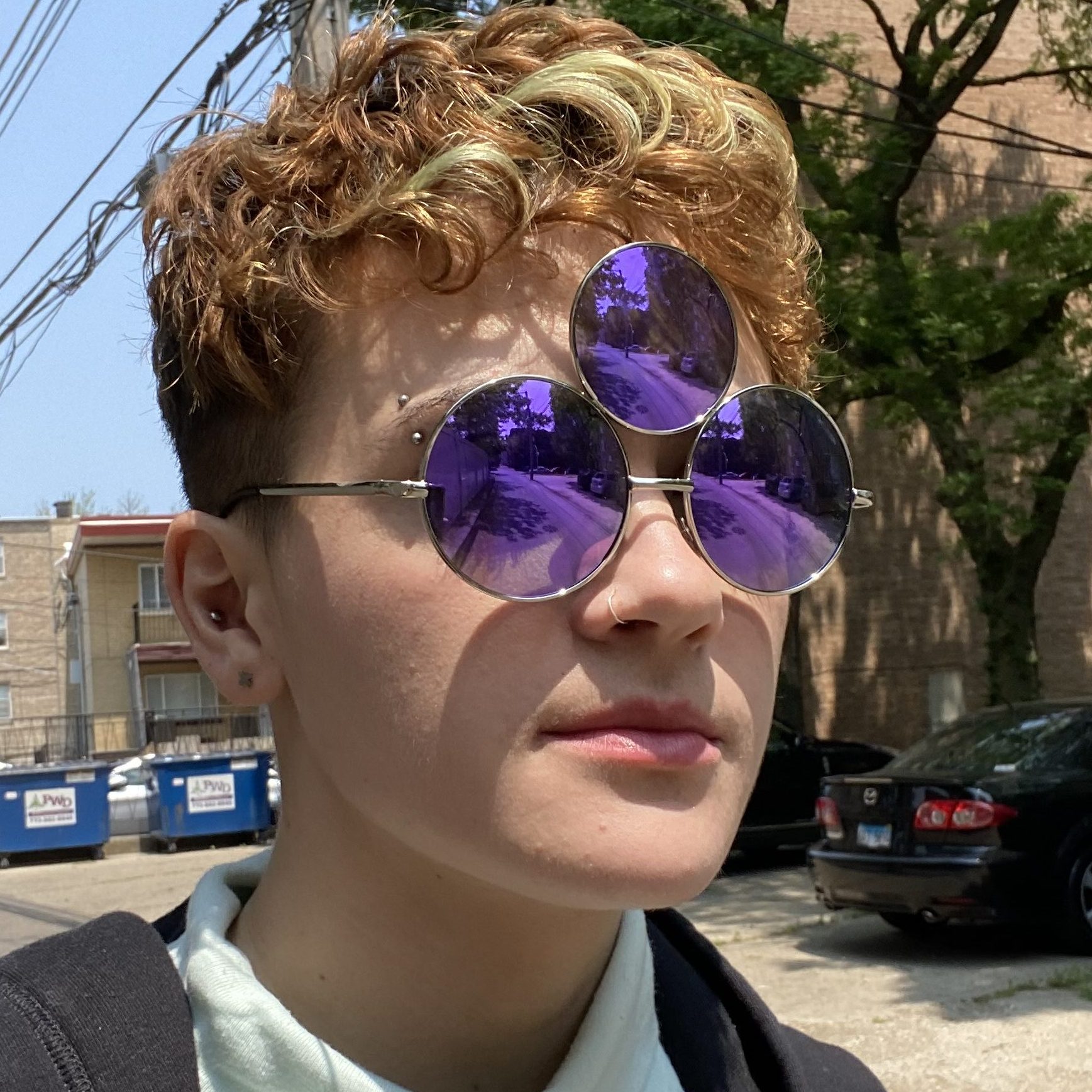
About the author: Maggie K. Rothberg is a writer, performer and researcher based in Rogers Park, Chicago. These days, Maggie is interested in problems of translation, queer intimacies, and the Old. Maggie has created performances on stage, on Zoom, on the street, and in libraries, churches, apartments and amphitheatres in Chicago, New York, Connecticut, London and Greece. Maggie is one half of the theater-making duo YOUNG KRONES (with Ava Calabrese Grob). Since closing their recent site-specific production, A DRAMA IN ROGERS PARK, Krones are currently occupied with infiltration of the local artisan market scene. Keep up with the Krones on insta: @youngkrones.
